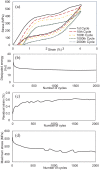Mechanical properties and constitutive models of shape memory alloy for structural engineering: A review
- PMID: 37970098
- PMCID: PMC10638093
- DOI: 10.1177/1045389X231185458
Mechanical properties and constitutive models of shape memory alloy for structural engineering: A review
Abstract
Shape Memory Alloys (SMAs) are an innovative material with the unique features of superelasticity and energy dissipation capabilities under extreme loads. Due to their unique features, they have a great potential to be employed in structural engineering applications under different conditions. However, in order to effectively use SMAs in civil engineering structures and model their behaviors accurately in Finite Element (FE) packages, it is crucial for structural engineers to comprehend the mechanical properties and cyclic behavior of different SMA compositions under varying loading conditions. While previous studies have focused mainly on the cyclic behavior of SMAs under tensile loading, it is important to evaluate their fatigue behavior under cyclic tension-compression loading for seismic applications. This literature review aims to discuss the current gaps in the existing literature on the behavior of SMA rebars under low-cycle fatigue (LCF). The review provides a comprehensive overview of the primary characteristics of SMAs, summarizes the mechanical properties of SMAs presented in the literature and the parameters that affect them, and critically evaluates the effects of cyclic loading and LCF on SMAs. The review also provides a summary of the different constitutive models of SMAs and compares their advantages and limitations, which helps structural engineers to employ an appropriate constitutive model for predicting the accurate behavior of SMAs in FE software.
Keywords: Shape memory alloys; buckling; cyclic behavior; finite element; low-cycle fatigue; tension-compression loading.
© The Author(s) 2023.
Conflict of interest statement
The author(s) declared no potential conflicts of interest with respect to the research, authorship, and/or publication of this article.
Figures


























References
-
- Abaqus G. (2011) Abaqus 6.11. Providence, RI: Dassault Systemes Simulia Corporation.
-
- Abdulridha A. (2013) Performance of superelastic shape memory alloy reinforced concrete elements subjected to monotonic and cyclic loading. Doctoral Dissertation, University of Ottawa, Ottawa.
-
- Abdulridha A, Palermo D. (2017) Behaviour and modelling of hybrid SMA-steel reinforced concrete slender shear wall. Engineering Structures 147: 77–89.
-
- Abraik E, El-Fitiany SF, Youssef MA. (2020) Seismic performance of concrete core walls reinforced with shape memory alloy bars. Structures 27: 1479–1489.
-
- Alam MS, Nehdi M, Youssef MA. (2007. a) Applications of shape memory alloys in earthquake engineering. In: Proceedings of the 9th Canadian conference on earthquake engineering, Ottawa, ON, 26–29 June, pp.26–29.
Publication types
LinkOut - more resources
Full Text Sources
Research Materials
